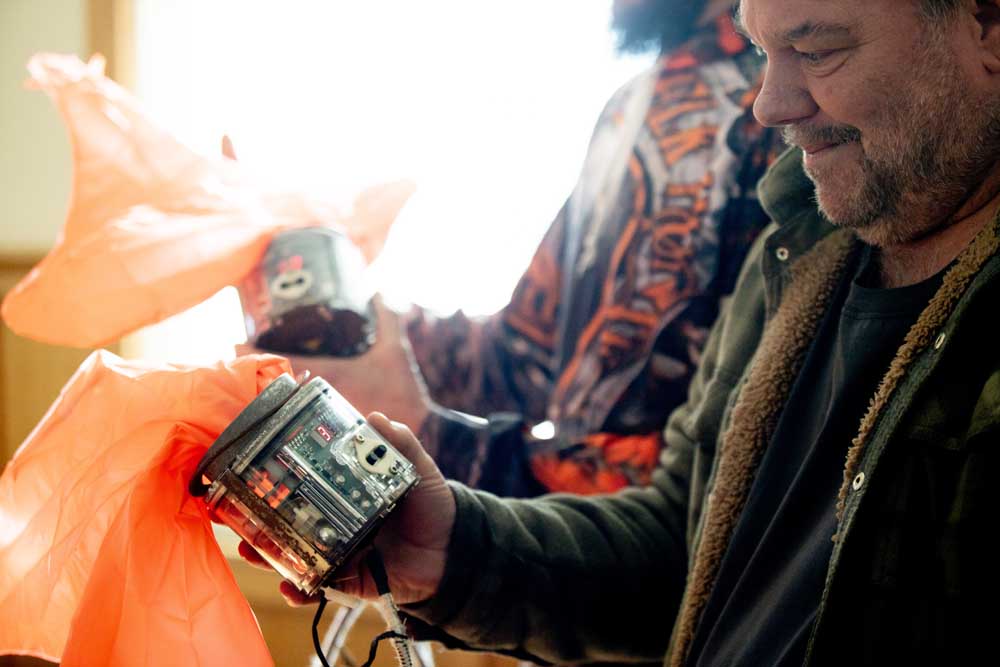Saints or Sinners? Characters of Pacific County: Witty, wise, unassuming ‘Mister History’
Published 8:01 am Thursday, November 21, 2024

- PCHS PhotoCharlie Nelson enjoyed working with youngsters at the Morehead Park 4-H camp, teaching them how to fish and then how to clean and filet their “prizes” so they were ready to cook. He often told stories about early fishing methods — fish traps and horse-seining as he worked.
Charles Nelson 1883 — 1978
Trending
Editor’s Note: The following was written some years ago as a tribute to Charley and Deane Nelson, pioneer family of the peninsula who lived at Nahcotta. Both had recently passed away. Dale Little, Sydney Stevens mother, died in 2009.
Charles Nelson was one of seven children raised in the smallest house — just three rooms — in Oysterville. My Great Uncle Willard (not to be confused with his nephew Willard Espy, the writer) was six months younger than Charlie and also one of seven children. The Espy house where Will was raised was three blocks to the north of the Nelsons’ and was one of the largest homes in Oysterville. The two boys were best friends.
Both boys remembered for their very long lives seeing the train arrive on its first trip all the way to its terminus in Nahcotta on May 29, 1889. They were both six years old. Charlie went to see the big event with his entire family and had invited Will along, but Will’s father said he could not leave home “under any circumstances.” (Perhaps this was because R.H. Espy had donated a large sum of money to Mr. Loomis with the understanding that the train would come all the way to Oysterville… which, of course, it didn’t.)
Trending
In any case, Will escaped, “requisitioned” someone’s horse, and galloped off to the celebration. He was fond of telling (with great satisfaction) that his mother made him stay upstairs in bed for two days as punishment for running away “but it was well worth it.” Will lived in California all his adult life so if he wasn’t around here to tell the story, Charlie told it for him and enjoyed every re-telling better than the last. (Also, I might add that Uncle Will was one of the “silent Espys” and would have deferred to Charlie’s version in any case.)
They were in the same class throughout their school years, attending the two-story Oysterville School, the first in the county to be supported by taxation. Oysterville School District #1 was also the first to have its teacher receive his stipend from the county rather than by subscription from the parents who could afford it. Thus, true “public education” in Pacific County had begun in Oysterville in 1870, some years before Charlie and Will were born.
One of Charlie’s not-so-fond memories of his school years was the frequent punishment for misbehaving at school: having to sit and stare at a certain page in the “New Revised and Illustrated copy of Webster’s Unabridged Dictionary, with 3000 Pictorials.” The page showed the stocks, pillory, ducking stool, guillotine, and the iron maiden — “a well-worn page,” Charlie often remembered.
Charlie was also present at the Pacific County Courthouse that slushy Sunday morning of Feb. 5, 1893, when the South Bend Raiders came to Oysterville and “stole the County Seat.” With him this time was the youngest Espy boy, Cecil. Charlie was 10; Cecil was 7.
According to Charlie, …”the whole thing lasted about an hour and a half and they were on their way back to South Bend with their loot… we saw the gang arriving in Oysterville and we didn’t know what was going on, so we went right along in with ‘em to see. Finally, we got in [and] found out that they were looting the county records. Cecil got scared and hid behind the front door and I was out among the crowd and I had to watch my toes so they didn’t get tramped on; I was barefooted at the time…
Charlie remembered other important people and events that had occurred during his growing-up years and he told about them often. He especially liked sharing the stories with youngsters — with the 4-H students at Camp Morehead as he taught them to clean and filet salmon, and with the campers at Alan and Barbie Greiner’s Camp Sherwood Forest as a guest at their evening bonfires.
Charlie spoke of Lum You, the only legally hanged man in Pacific County and of how kind he had been to kids — always had a sweet for them and a funny story.
Charlie spoke of Lum You, the only legally hanged man in Pacific County and of how kind he had been to kids — always had a sweet for them and a funny story. He remembered the high-prow canoes that came into Oysterville on the occasion of Myrtle Johnson Woodcock’s birth in 1889 — “the last Indian Princess of Pacific County,” he called her. And he was witness to the “rescue horses of Klipsan” saving crew members of the wrecked SS Strathblane in 1891 when his father was the Lookout at the Ilwaco Beach Life Saving Station (renamed in 1912 to the Klipsan Beach Life Saving Station.)
Charlie shared some of those memories when he spoke along with the surviving Espys of his generation at the Oysterville Centennial in 1954. And he was proud of the artifacts rescued from various shipwrecks in the area — like the sideboard and one of the dining tables that his father, the mail-carrier, had found floating in Shoalwater Bay from the wreck of the Lammerlaw in 1881. The furniture graced Charlie and Deane’s dining room in Nahcotta for the half-century they lived there — a Sears & Roebuck “kit-built” house they constructed in 1926. During those years, Deane was the Nahcotta postmaster and Charles had established himself as a “north-end” cranberry grower.
Historian Ruth Dixon wrote of Charles in the 1966 Summer issue of the Sou’wester: “Charles Nelson was a charter member of the historical society in 1949, President in 1953, a member of the Board of Directors 1961 to 1966, and a frequent speaker at society functions. One of the lads ‘with bright sea-eyes.’
“Charles Nelson of Nahcotta — witty, wise, unassuming, with the squint that marks the seaman, he is now our “Mister History: Never cocksure, always thoughtful, researchers become familiar with his sincere promise: “I’ll try to find out” He usually succeeds. Our pioneer history, to a great extent, consists of the current events of his youth.”









